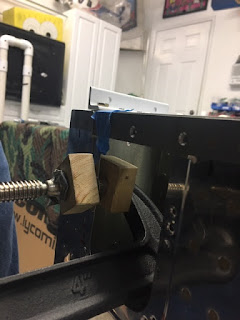So I started finishing the wiring. My goal is to get all the wires in the fuselage before starting the engine and instruments. This will keep me from having to bend over and under the panel to install the wires and fuel lines on the fuselage floor. The wiring from the spar back was all done a month ago, but the wiring on the floor, in front of the spar, took some doing. This involved planning out all the wiring runs and finding enough holes in the spar to bring the wires through. It also meant I had to install the transponder and comm antennas to get those cables routed. I had to use a cat5e computer cable to get all the stick grip signals to the instrument panel; running individual wires for all the functions on the grips would have never fit through the existing spar holes. The cat5e cable used 4 pairs of 28 AWG wires in a very tight bundle, giving me 8 functions spread between the two stick grips.
I also put in the parking brake and made a bracket for the parking brake cable and the micro switch to tell me the parking brake is on.
Next up is the fuel system final install on the fuse floor. This has already been installed, but now it is time for final install.
In my spare time, I have been creating the panel wiring schematic. It seems I need 6 each RS232 outputs but only have 5 available. The G3X experts from Garmin helped me out and said if I run an independent GPS antenna for the G5, then I don't need a 6th RS232 output. I think that is what I will do; this will make the G5 a true system backup, able to get me to VFR weather if everything else goes COVID on me.






















